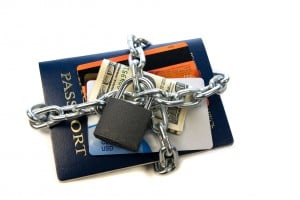
[message_box type=”note” icon=”yes”]Check out more tips on traveling and join the conversation on our forums. Open Forums[/message_box]
 Do you take pride in being a responsible, well-informed traveler?
Do you take pride in being a responsible, well-informed traveler?
I certainly do. I read up on local history and customs, take time to learn at least a few words in the local language, never wear white tennis shoes in Europe, and make active decisions about protecting my valuables.
So you can imagine how surprised I was to find myself standing with my husband outside the closed American Embassy in Bratislava with no passport, missing credit cards, an international flight scheduled to leave in 12 hours, and no clear idea about what to do next.
How do you protect yourself from this kind of travel experience? (I refuse to say “disaster”, incidentally. Having your passport buried in rubble from an earthquake is a disaster. Losing it IS a nasty shock, however.)
And how do you deal with the loss if it happens?
Here are 4 easy steps to avoiding loss or theft of your passport. And, because no plan is foolproof, the 5th step reviews what to do if it happens.
1. Do not keep your passport, cash and credit cards together.
I thought I was being a wise, careful traveler when I got my husband a shiny new “RFID-blocking” leather passport/wallet combination. No one could steal the data from our chips now. He looked like a spy on a mission, like a traveling diplomat. Everything was together, easy to keep track of.
Huge mistake. Huge. Because when everything’s together, then every time you need to pay for anything, you have to get it all out. And, if you’re dealing with cash, which you will in many countries, you have to lay everything down, organize packages, separate cash and coins, and get it all put away.
And at some point, you will lay it down and that will be the end of it. Keep your cash separate from your credit cards, and keep your passport separate from everything else.
Thieves don’t actually want your passport. In fact, most of them don’t even want your credit cards. Credit card theft is easier to trace and the risks are higher. And passports are not easy to sell. Ask the police, and you will discover that passports and credit cards are usually found in a convenient dumpster.
What the thief wants is your cash. So carry cash, but only what you need that day. If you discover it’s missing, it’s only a little and you can replace it from the stash you left in the hotel safe. But if you discover your passport is missing, the fun stops till it’s replaced. And when you start adding up charges for changing flights, extra hotel days, extra meals, transportation and replacement passport charges… losing your passport is not just a scary hassle, it’s also very expensive.
2. When you get to your hotel, leave your passport in the safe.
You need your passport at the airport. But once you get to the hotel, leave it.
I know, the State Department says to carry it with you. But virtually every hotel has a safe, and many of my most traveled friends leave their passport there. You can leave your extra cash and extra credit cards there, too.
It works great while you stay in one place. The problem, of course, comes when you move around. We’ve all left things behind. Which presents a whole new scenario.
You know who you are, and whether the safe is a good idea for you or not. Still, it has to be said-many experienced travelers find the hotel safe to be the smartest, easiest and safest choice for passport protection.
3. If you decide to carry your passport with you at all times, like the State Department says, then carry it close, and in a place you never have to access.
I’m a rule-keeper, so I carry mine. And besides, having my passport seems to present at least some level of protection should things suddenly go bad. But if you carry it with you, it’s for official emergencies, not for flashing.
You can wear one of those “inside your clothes” pouches, though for heaven’s sake do wear it inside your clothes, not outside. If you hang it around your neck, possibly with your money as well, you might as well put up a flag that says “Steal this!”
And please, be sure the little tie thingie doesn’t show. It just looks silly.
You can tell I’m not a fan of inside pouches. Probably because I can’t think of any place where I’d really like that kind of a bulge. I wear a small shoulder bag with an inside zip pocket, where my passport goes and never comes out. It’s close to my chest, under my arm, and behind two zippers. And any wandering hands encounter my fake wallet first.
The most important thing is not to put your passport where you have to get it out. Ever. Getting it out defeats the purpose of secreting it away, and ups your chances of losing it. That’s exactly how my husband lost his.
4. Do not invest in an expensive leather RFID case. For anything.
Get a cheap RFID-blocking paper sleeve, for your passport, or for your credit cards. Office Depot and Staples have them for about $5. They block electronic theft just as effectively as leather, they’re lighter, they lie flatter, and they won’t tempt you to flash them because they’re too cool to hide.
And remember-cash doesn’t need electronic protection, and you don’t have to call anyone if it’s lost.
5. Nothing is foolproof, and we’re all fools sometimes.
Before you leave, make two color copies of your passport and your birth certificate. Put one set in your suitcase and one in your carry-on. If you have some extra ID, put that in as well. It all makes getting a new passport much easier. And if the worst happens, file a police report. You can’t go to the Embassy till they open anyway, and filing a report makes you look responsible.
So. Wisdom for smart travelers. Having your passport handy may seem like a cool, “world traveler” kind of thing to do. But having it hidden securely away gives you the freedom you need to have the journey you want.
Dr. Deborah Kukal is a licensed psychologist with a broad sense of her home in the world. She is Board Certified in Health Psychology, and she writes on health, sleep, spirituality and meditation, as well as life enrichment, travel and current events.
Discover resources for healthy living, including guided meditation experiences to enrich your own life. They’re free and downloadable, at http://www.thehomeinyourheart.com.
The home in your heart. Where mind and body touch one another.
Article Source: http://EzineArticles.com/expert/Deborah_Kukal,_Ph.D./13179
Article Source: http://EzineArticles.com/9681189

